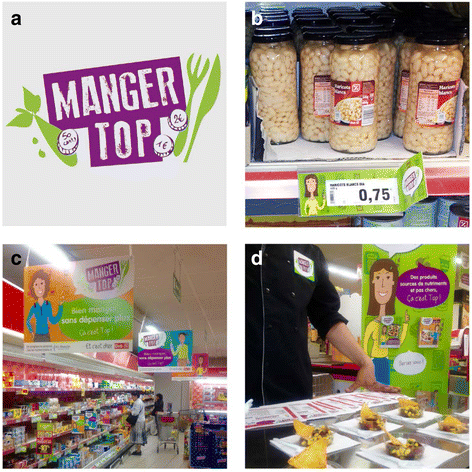In-store marketing of inexpensive foods with good nutritional quality in disadvantaged neighborhoods: increased awareness, understanding, and purchasing
- PMID: 27677446
- PMCID: PMC5039802
- DOI: 10.1186/s12966-016-0427-1
In-store marketing of inexpensive foods with good nutritional quality in disadvantaged neighborhoods: increased awareness, understanding, and purchasing
Abstract
Background: Consumers often do not understand nutrition labels or do not perceive their usefulness. In addition, price can be a barrier to healthy food choices, especially for socio-economically disadvantaged individuals.
Method: A 6-month intervention combined shelf labeling and marketing strategies (signage, prime placement, taste testing) to draw attention to inexpensive foods with good nutritional quality in two stores located in a disadvantaged neighborhood in Marseille (France). The inexpensive foods with good nutritional quality were identified based on their nutrient profile and their price. Their contribution to customers' spending on food was assessed in the two intervention stores and in two control stores during the intervention, as well as in the year preceding the intervention (n = 6625). Exit survey (n = 259) and in-depth survey (n = 116) were used to assess customers' awareness of and perceived usefulness of the program, knowledge of nutrition, understanding of the labeling system, as well as placement-, taste- and preparation-related attractiveness of promoted products. Matched purchasing data were used to assess the contribution of promoted products to total food spending for each customer who participated in the in-depth survey.
Results: The contribution of inexpensive foods with good nutritional quality to customers' total food spending increased between 2013 and 2014 for both the control stores and the intervention stores. This increase was significantly higher in the intervention stores than in the control stores for fruits and vegetables (p = 0.001) and for starches (p = 0.011). The exit survey revealed that 31 % of customers had seen the intervention materials; this percentage increased significantly at the end of the intervention (p < 0.001). The in-depth survey showed that customers who had seen the intervention materials scored significantly higher on quizzes assessing nutrition knowledge (p < 0.001) and understanding of the labeling system (p = 0.024).
Conclusion: A social marketing intervention aimed at increasing the visibility and attractiveness of inexpensive foods with good nutritional quality may improve food purchasing behaviors in disadvantaged neighborhoods.
Keywords: Exploratory study; Intervention; Low-income; Nutrient profiling; Nutrition information; Price; Sales; Shelf labeling; Social marketing.
Figures
References
-
- Regulation No 1169/2011 of the European Parliament and of the Council of 25 October 2011 on the provision of food information to consumers. Official Journal of the European Union L304/18. 2011.
-
- Grunert KG, Wills JM. A review of European research on consumer response to nutrition information on food labels. J Public Health. 2007;15(5):385–99. doi: 10.1007/s10389-007-0101-9. - DOI
LinkOut - more resources
Full Text Sources
Other Literature Sources


